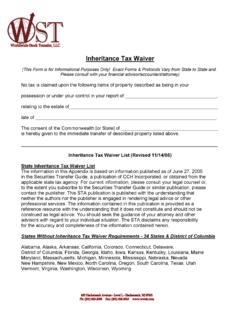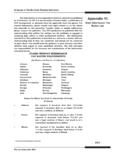Transcription of THE POTENTIAL RISKS OF JOINT TENANCY
1 THE POTENTIAL RISKS OF JOINT TENANCY By Martha L. Ridgway JOINT TENANCY is a legal relationship in which two or more people own property which is subject to titling, such as real estate, cars, bank accounts, money market accounts, certificates of deposit, etc., in both or all of their names. (For the sake of simplicity, the remainder of this discussion will refer to two people only. However, keep in mind that any number of people can be included in JOINT TENANCY .) Under JOINT TENANCY , each person, called a JOINT tenant , has an ownership interest in the entire property that is subject to the JOINT TENANCY . Thus, each JOINT tenant does not own one-half, for example; together, each JOINT tenant owns 100%. Another feature of JOINT TENANCY is the fact that the ownership of the property automatically and instantly passes to the surviving JOINT tenant upon the death of the other JOINT tenant .
2 For example, if John Doe and Mary Doe own a home in JOINT TENANCY , they each own the entire home; they do not each own one-half. If John dies, Mary still owns the entire home, only now in her name alone. The legal language that creates a JOINT TENANCY is typically as follows: as JOINT tenants with rights of survivorship and not as tenants in common. Tenants in common, which is different from JOINT TENANCY , refers to a property ownership arrangement in which each person owns a particular percentage of the property; he or she does not have a 100% ownership interest. (Like JOINT TENANCY , more than two people can own property as tenants in common. Again, for the sake of simplicity, I will refer to two people only.) In addition, and very importantly, one owner s interest does not automatically pass to the surviving owner upon death.
3 For example, John Doe could own a 45% interest in the home, and Mary Doe could own a 55% interest. When John dies, as tenants in common, his interest does not automatically belong to Mary. Rather, it will pass to the person(s) named in his will or trust or, if he has none, according to state law. (When a person dies without a will or a trust, it s called dying intestate. The deceased person s property passes according to the state laws of intestacy, as determined by the legislature.) The survivor in this instance, Mary, still owns 55% of the property. JOINT TENANCY may be a useful tool in some limited circumstances. For example, if a husband and wife have a simple, non-taxable estate, and they want to ensure that the surviving spouse receives the home, the money and the property the couple has saved together, upon the death of the first to die, JOINT TENANCY may be appropriate.
4 (This does not, however, mean that the couple should not have a will and/or trust as a safety net. ) Another example in which JOINT TENANCY may be useful is a situation in which a parent wishes to entrust a small bank account to an adult child or other trustworthy person, thereby giving that person the power to pay the parent s bills and to pay the parent s last illness and funeral expenses. (An alternative is placing an adult child s name on an account as a signor, but not as an owner.) Other than these two circumstances, however, JOINT TENANCY can be a dangerous legal tool, and typically is not a good idea for the following reasons. Page 2 1. JOINT TENANCY can undermine an estate plan. Because JOINT TENANCY property passes to the surviving JOINT tenant instantly upon death, such property does not pass according to the deceased JOINT tenant 's will or trust.
5 In other words, JOINT TENANCY has priority over a will or trust. Consider the following example: A couple has gone to a great deal of legal planning and expense to ensure that their estate plan is set up in a certain way, particularly because they have a taxable estate or because they have set up trusts within their wills. If the couple then titles property in JOINT TENANCY , they may completely undo the estate plan because JOINT TENANCY property overrides a will or trust provision. This means that their property may not pass the way they intended it to and may cause their tax planning to be undone. 2. JOINT TENANCY inadvertently can lead to one child receiving a parent s entire estate, to the exclusion of other children or other beneficiaries.
6 Another example of a problem with JOINT TENANCY , which is similar to the problem above, is instructive: A widowed/elderly parent wants to leave $10,000 to the Humane Society and the balance of her estate equally to her three children and prepares a will to that effect. But then, she innocently puts all of her property in JOINT TENANCY , in the name of her daughter and herself, "for the sake of convenience and because I know she ll do the right thing." Unfortunately, upon the death of the mother, all of the property held by the daughter in JOINT TENANCY will automatically belong to the daughter, by-passing the mother's will, and leaving nothing to the other two children or to the Humane Society. The daughter may have a moral obligation to share the mother's estate equally with her siblings and the Humane Society, but she may have no legal obligation to do so.
7 In other words, she may not do the right thing. 3. JOINT TENANCY can create hostility among family members. Often, an elderly parent will place property in JOINT TENANCY with one of several children, usually one who lives in close physically proximity, for convenience, not unlike the example in #2, above. This often can lead to jealousy, hostility and allegations of favoritism among the siblings and the parent. Furthermore, it is not unusual for the child in whose name the assets are placed to be accused by the siblings of exerting undue influence over the parent. All of these factors can lead to litigation, even while the parent is still alive. 4. JOINT TENANCY can place a person s assets at risk. All JOINT tenants are owners of the JOINT TENANCY property.
8 Therefore, even if a JOINT tenant does not think about the property as being hers (for example, she considers it to be her father's property, but her name was added for convenience), by law, it is still hers because her name is on the title. Therefore, the JOINT TENANCY property is placed at the same risk as any other property owned by that person. For example, the property could be placed at legal risk if the co-owner (here, the daughter) files for bankruptcy, is sued, gets divorced, has problems with the law, etc. As an example, an elderly father adds his son's name in JOINT TENANCY to the father's home for convenience. The son goes through a nasty divorce. Because the son owns the property, along with his father, the son's Page 3 wife could attempt to bring the father's property into the divorce case, claiming that she is entitled to an interest in it.
9 In another example, if the son is sued, and if a judgment is entered against him, the father's assets may be at risk if the son's name also appears on the assets as a JOINT tenant . 5. JOINT TENANCY can cause a loss in Medicaid eligibility. Note: the following comments are specific to Colorado law, and may not apply in other states. Additionally, the Medicaid laws change frequently and can quickly become out-of-date. In Colorado, if an elderly person transfers the house from his name alone into JOINT TENANCY , even for convenience, the state Medicaid agency will treat that transaction as a transfer without fair consideration, which could result in the elder not being eligible for Medicaid benefits for a period of time.
10 This is referred to as a transfer penalty. Also in Colorado, the home is exempt for Medicaid eligibility purposes. This means that the value of the home is not counted in determining if a person qualifies for Medicaid. However, if the home is transferred into JOINT TENANCY , except in a few circumstances, it loses its exempt status, and its value becomes a countable resource in determining Medicaid eligibility. Because most homes are still so valuable, this means most people will no longer be eligible for Medicaid. 6. Probate is not a process to be feared. Many people use JOINT TENANCY as a means of avoiding probate, the process by which assets are transferred from a deceased person to his or her heirs, either by will or intestate succession.







